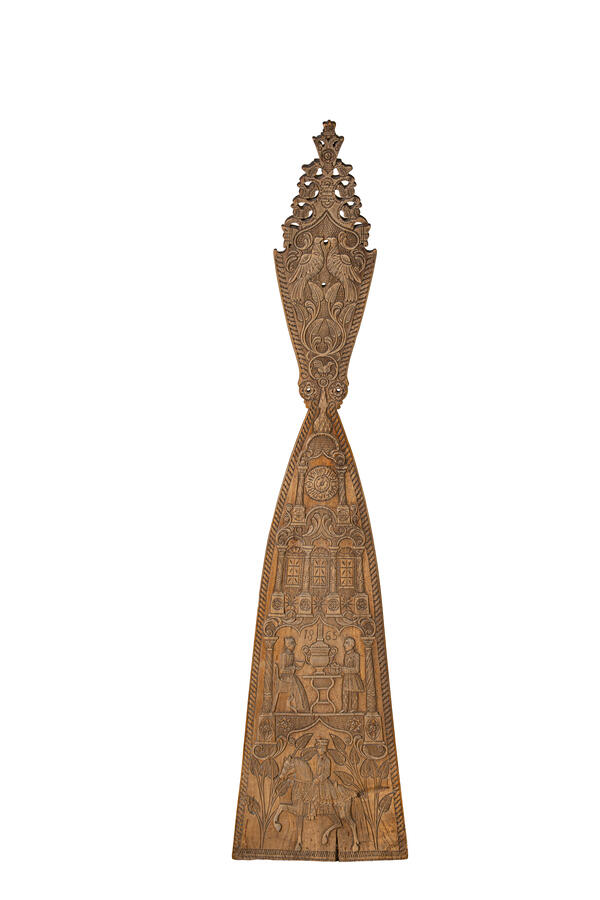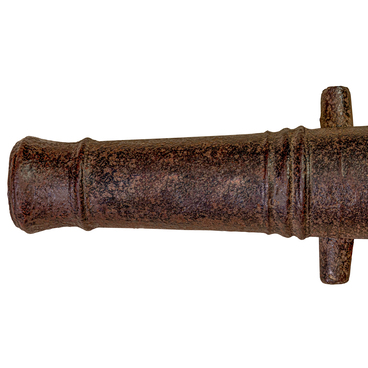A distaff is a device for spinning threads. It has three main parts: a blade, a leg and a bottom. The spinning process was quite simple, but required skill and dexterity. Flax tow — flax fiber, hemp or wool — was fixed to the back of the blade. The woman sat on the edge of the bottom and twisted the flax tow into a thread, pulling and winding it on the spindle. There was a great variety of distaffs in various regions of Russia. They differed in design, shape, manufacturing technique and decor.
“Teremkovye” is a common name for all the distaffs, on which the image of the terem (fairy-tale tower) was usually carved as a decoration. Such were found in the south of Vologda, the north of Yaroslavl and the west of Kostroma provinces. Tower-type distaffs were made from the root part of the birch: the vertical part (leg and blade) was carved from the trunk, the horizontal part (bottom) — from the root.
This distaff from the village Kinderevo of the Yaroslavl region was brought to the museum by participants of a scientific expedition in 1966. It belongs to one of the varieties of “teremkovye” distaffs, which distinguish themselves by the carving technique. The local name of such distaffs is “Kinderevskye kopyly”, after the name of the village where they originate from.
The front vertical part of the distaff is entirely covered with rich, intricate carving, which required a high level of skill. In the upper part of the blade there is an image of a tree with birds and horse heads, and in the lower part there are two birds sitting with their breasts to each other. The top of the distaff is crowned with a double-headed eagle. The main visual accent of the leg is the tea-party scene. In a luxurious multi-tiered interior with columns and large glazed windows, a man and a woman are depicted on the sides of a table with a samovar. The date of the creation of the distaff is also carved here —1865. In the lower tier of the distaff is a man riding a prancing horse. The influence of the country gentry culture is noticeable in the architectural motifs, ornaments, clothes of the characters and the theme of the composition.
Tower-type distaffs have always been a special pride of the hostess. Such a distaff was cherished, inherited, and in some provinces, where several different types of distaffs were common, teremkovye distaffs were considered fashionable and expensive. It was them, that taken to gatherings (posidelki), and simpler in shape and decor distaffs were used everyday.
“Teremkovye” is a common name for all the distaffs, on which the image of the terem (fairy-tale tower) was usually carved as a decoration. Such were found in the south of Vologda, the north of Yaroslavl and the west of Kostroma provinces. Tower-type distaffs were made from the root part of the birch: the vertical part (leg and blade) was carved from the trunk, the horizontal part (bottom) — from the root.
This distaff from the village Kinderevo of the Yaroslavl region was brought to the museum by participants of a scientific expedition in 1966. It belongs to one of the varieties of “teremkovye” distaffs, which distinguish themselves by the carving technique. The local name of such distaffs is “Kinderevskye kopyly”, after the name of the village where they originate from.
The front vertical part of the distaff is entirely covered with rich, intricate carving, which required a high level of skill. In the upper part of the blade there is an image of a tree with birds and horse heads, and in the lower part there are two birds sitting with their breasts to each other. The top of the distaff is crowned with a double-headed eagle. The main visual accent of the leg is the tea-party scene. In a luxurious multi-tiered interior with columns and large glazed windows, a man and a woman are depicted on the sides of a table with a samovar. The date of the creation of the distaff is also carved here —1865. In the lower tier of the distaff is a man riding a prancing horse. The influence of the country gentry culture is noticeable in the architectural motifs, ornaments, clothes of the characters and the theme of the composition.
Tower-type distaffs have always been a special pride of the hostess. Such a distaff was cherished, inherited, and in some provinces, where several different types of distaffs were common, teremkovye distaffs were considered fashionable and expensive. It was them, that taken to gatherings (posidelki), and simpler in shape and decor distaffs were used everyday.



